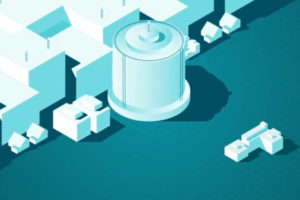


Episode 01
Nuclear Katie: Why net-zero needs nuclear
Welcome to Climate Challengers! In our very first episode Andrea will be discussing why we’re doing this podcast, what you can expect, and is joined by featured guest, Katie Mummah. Andrea and Katie will discuss the relationship between nuclear and net-zero, as well as clear up some misconceptions.
Net-zero needs nuclear, and Nuclear Katie is ready
You don’t need to be a climate scientist to know that the climate crisis is getting worse. Every day, millions more tons of greenhouse gases are added to earth’s thin atmosphere, and it’s getting hard not to notice. Wildfires. Droughts. Rising seas. You know the rest.
But what if someone told you that there was a ready-made, off-the-shelf technology that could be substituted for fossil fuels? And what if they added that this technology could provide the same energy as renewables, but by using hundreds of times less land? Or that it could generate power with the least amount of natural resources per unit of energy of any existing technology? You might say that sounds too good to be true. Or, you might say that sounds like nuclear energy—and you’d be right.
Read more...
Nuclear Katie was born Katie Mummah in the suburbs of Chicago. A chance encounter with two nuclear engineers in high school set Katie down a path that would lead her to become a nuclear engineer herself, but also one of North America’s most enthusiastic advocates of nuclear energy’s role in the race to net-zero.
“I wanted to tackle hard challenges and work on something that can save the world,” Katie told The Climate Challengers podcast host Andrea Bain. Today, Katie is a Nuclear Engineering and Engineering Physics graduate student at the University of Wisconsin-Madison. She describes her research as exciting, challenging and giving her the opportunity to work towards a larger goal of reducing emissions and stopping the worst of climate change. But it’s her work outside the classroom that is getting attention. For Katie, the way nuclear engineers communicate with the public and with policy makers is of critical importance.
“If you are a nuclear engineer, you have to communicate,” says Katie. She’s found that, for a lot of people, their only exposure to nuclear energy is through pop culture (sector 7-G, anyone?) or well publicized disasters such as Chernobyl or Three Mile Island. It didn’t help that the industry’s response to these accidents was to “get really quiet” and hope people would forget.
People did not forget, but they did grow weary of a clean energy technology that is going to be essential to slowing the heating of the planet and keeping temperatures below catastrophic levels. This is the challenge that turned Katie Mummah into Nuclear Katie. She saw the need for better public communication of the benefits—and risks—of nuclear energy, and she is running with it.
For Katie, the biggest roadblock is that there are no magic answers. Every energy source has its benefits and drawbacks, so changing people’s sentiment about nuclear is something that needs to happen on a community-by-community basis. “We need to have small conversations about what can nuclear power can do for your community,” says Katie, adding that “it is an exciting time to be in nuclear engineering.”
Katie is referring to the thriving start-up culture that has emerged in the nuclear space over the past decade, with several innovative young firms vying to demonstrate new nuclear technologies and bring them to the market.
SMRs, or Small Modular Reactors, are one such innovation that has Katie and others excited about the future. Unlike the large nuclear plants of previous generations, which were all built as one-offs, SMRs are duplicatable: the same design can be built over and over again to meet a variety of energy needs. It is thought that SMRs will be especially helpful in electrifying global transportation systems, a critical step towards a net-zero economy.
To get clean power into the really hard to reach places, like Canada’s north where mining operations or many off-the-grid communities still rely on diesel generators to create electricity, a new generation of micro-reactors offer a 24/7 carbon-free solution because they can scale down to just a few megawatts.
Still, no matter how promising the technologies in the pipeline are, Katie understands that they won’t get drafted into the fight against climate change without better public understanding of and support for nuclear power. Katie spends a lot of time countering safety misconceptions associated with nuclear power. Her approach is not to challenge people or call them out for their misconceptions, but to meet them where they are. “The way I try to have these discussions is by constantly reaffirming that it’s okay and it’s reasonable to have these fears and not that they’re wrong and stupid for having these concerns, but in fact they’re smart for engaging with these ideas,” said Katie. “The important thing is to approach these conversations gently.”
Getting to net-zero is a big task. But doing it within the next thirty years will be monumental, especially given that global energy consumption is forecast to rise another 50 per cent over this period. The math is impossible to argue with: for the developed world as well as the developing, there is no way to meet the rising demand for energy and reach net-zero without nuclear power.
Take the case of the province of Ontario where its publicly-owned generator, Ontario Power Generation (OPG), undertook to close all of its coal stations. When Ontario was burning coal, the electricity sector contributed 17 per cent of the province’s total emissions. But after April 2014, when OPG burned its last piece of coal, electricity contributed just 2 per cent of Ontario’s emissions. It still stands as the world’s single largest climate change-specific action, and it could not have happened without nuclear power.
To get off coal—and quickly—Ontario contracted new generation from wind and solar. But the backbone of Ontario’s electricity system, hydro power, providing 25 per cent of electricity generating capacity, and nuclear, providing 60 per cent, are really what allowed the province to close its coal power plants and become a world-leader in reducing the carbon intensity of its electricity grid and industries.
To continue decarbonizing Ontario and continue leading the world in the fight against climate change, in 2020 OPG committed to becoming a net-zero company by 2040 and a catalyst for helping other businesses achieve net-zero by 2050. With the refurbishment of existing nuclear plants well underway and OPGs investments into the SMRs of the future, Ontario is well positioned to continue electrifying its economy and driving down emissions.
Here, Ontario is not alone. It is no coincidence that the places that are winning the race towards decarbonization and net-zero—Sweden, France, Belgium—are also places that have invested heavily in nuclear. In fact, according to the International Energy Association, "Over the past 50 years, the use of nuclear power has reduced CO2 emissions by over 60 gigatonnes – nearly two years’ worth of global energy-related emissions." That’s a promising statistic, but it is just a start. To get to net-zero—and fast—the world needs far more nuclear.
Nuclear Katie, for her part, is optimistic. She wants the next decade to be as disruptive as the last one, with new technologies and possibilities that will enable the wider adoption of nuclear energy. Katie is proud to call herself a climate challenger, because she is standing up and working towards a world with fewer CO2 and a world where we limit the worst effects of climate change. “We’re not challenging the science of climate change, we’re challenging the CO2 molecules in the atmosphere.”
Facts about nuclear
60%+
of Ontario's power is generated by carbon-free nuclear energy
60+ gigatonnes
of CO2 emissions (worldwide) are avoided by using nuclear power
1 soda can
can store one person's entire lifetime worth of fuel waste from 100% nuclear power
Nuclear by-products
may be recycled as an energy source in the future
Clean energy topics
Other episodes
The information, statements, comments, views and opinions expressed during this podcast are solely those of the program participants and do not necessarily represent those of Ontario Power Generation Inc. or its affiliates.











